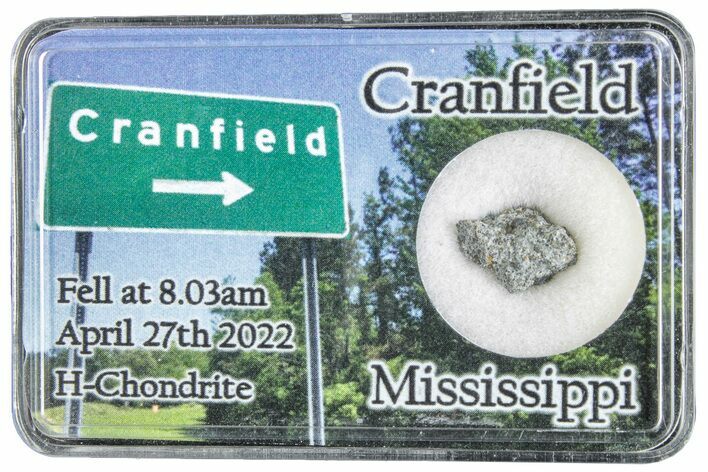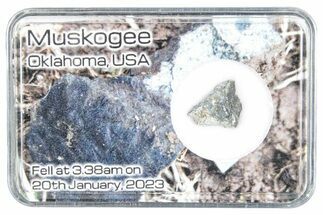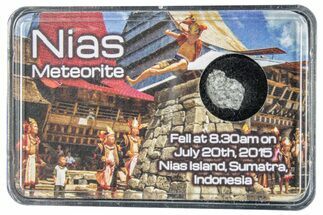.4" Cranfield Meteorite Fragment (0.36 g) - 2022 Witnessed Fall
This is a fragment from the H3-5 chondrite known as Cranfield, which fell near natchez, Mississippi on the morning of April 27, 2022. It comes in its own labeled display case.
This H3-5 chonrdite landed in a sparsely populated area of Mississippi called Cranfield just after 8:00AM on April 30, 2022. Eyewitnesses saw the incoming fireball and felt sonic booms as it exploded in the atmosphere, while Doppler radar tracked it to a rough estimate of its landing site. Three days later, a team of meteorite hunters found the first few stones on both the median and shoulder of eastbound US Highway 84. Since its fall about 600 total grams have been recovered.
Cranfield is classified as a high-iron chondrite with good fusion crust on most of its pieces. The interior is brecciated, often containing light gray clasts in a dark gray matrix also full of chondrules and metal grains.
Cranfield is classified as a high-iron chondrite with good fusion crust on most of its pieces. The interior is brecciated, often containing light gray clasts in a dark gray matrix also full of chondrules and metal grains.
About Chondrites
Chondrites are stony (non-metallic) meteorites that have not been modified by either melting or differentiation of the parent body. They are formed when various types of dust and small grains in the early Solar System accreted to form primitive asteroids. Some such bodies are captured in the planet’s gravity well and pulled to the surface. They are by far the most common type of meteorite, representing about 86 percent of all meteorites that have fallen to Earth.
Prominent among the components present in chondrites are the enigmatic chondrules, millimeter-sized spherical objects that originated as freely floating, molten or partially molten droplets in space; most chondrules are rich in the silicate minerals olivine and pyroxene. Chondrites also contain particles of various metals such as nickel, iron, and aluminum. These formed at the very beginning of the solar system and aggregated over time: they are the oldest rocks known on Earth!
Chondrites are divided into about fifteen distinct groups on the basis of their mineralogy, bulk chemical composition, and oxygen isotope compositions. The various chondrite groups likely originated on separate asteroids or groups of related asteroids. Each chondrite group has a distinctive mixture of chondrules, refractory inclusions, matrix (dust), characteristic chondrule sizes, and other components. Other ways of classifying chondrites include weathering and shock. The L chondrite group is the most common of these.
Chondrites are stony (non-metallic) meteorites that have not been modified by either melting or differentiation of the parent body. They are formed when various types of dust and small grains in the early Solar System accreted to form primitive asteroids. Some such bodies are captured in the planet’s gravity well and pulled to the surface. They are by far the most common type of meteorite, representing about 86 percent of all meteorites that have fallen to Earth.
Prominent among the components present in chondrites are the enigmatic chondrules, millimeter-sized spherical objects that originated as freely floating, molten or partially molten droplets in space; most chondrules are rich in the silicate minerals olivine and pyroxene. Chondrites also contain particles of various metals such as nickel, iron, and aluminum. These formed at the very beginning of the solar system and aggregated over time: they are the oldest rocks known on Earth!
Chondrites are divided into about fifteen distinct groups on the basis of their mineralogy, bulk chemical composition, and oxygen isotope compositions. The various chondrite groups likely originated on separate asteroids or groups of related asteroids. Each chondrite group has a distinctive mixture of chondrules, refractory inclusions, matrix (dust), characteristic chondrule sizes, and other components. Other ways of classifying chondrites include weathering and shock. The L chondrite group is the most common of these.
$525
TYPE
Ordinary Chondrite (H3-5)
LOCATION
Cranfield, near Natchez, Mississippi
SIZE
.4" wide, Weight: 0.36 grams
CATEGORY
ITEM
#285862
 Reviews
Reviews









